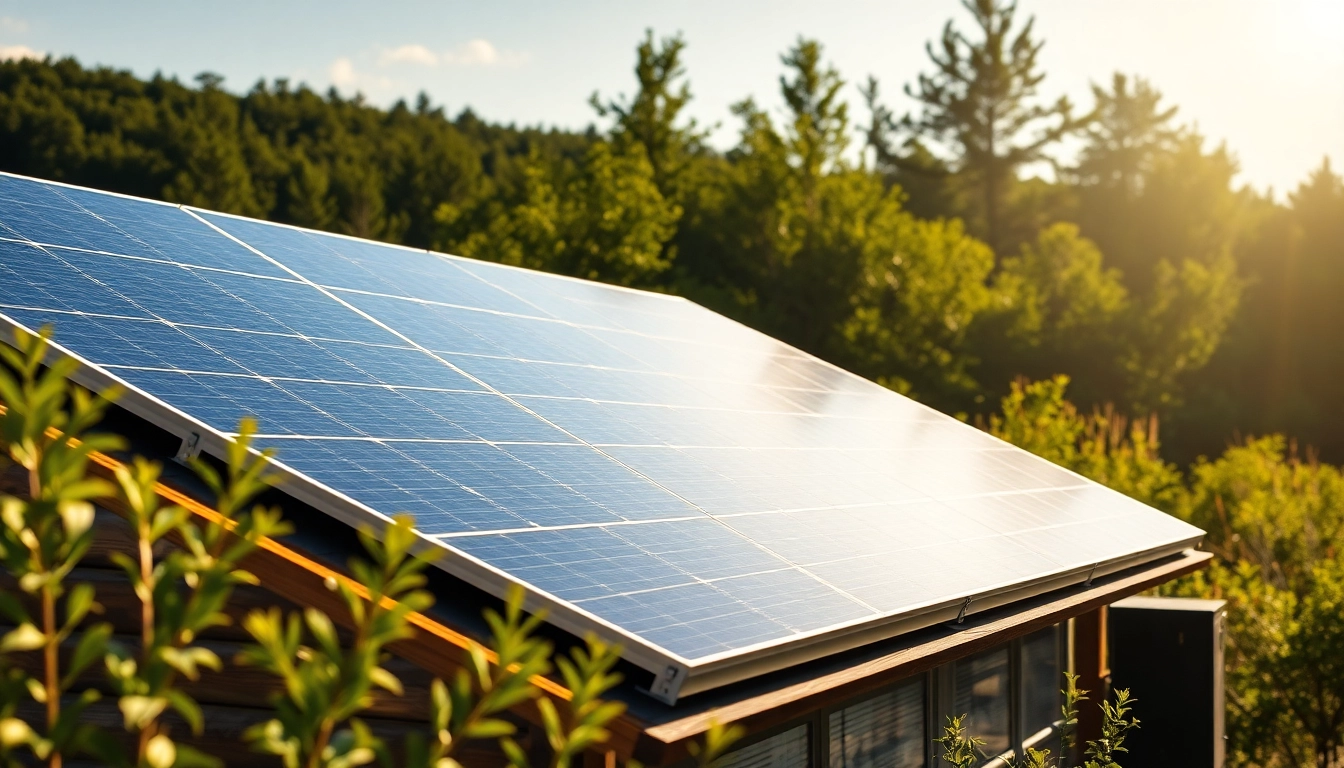Understanding the Off Grid Solar System
Definition and Basics of Off Grid Solar Systems
An off grid solar system is a self-sufficient energy system that utilizes solar panels to generate electricity independently of a traditional utility grid. This means that the energy produced is stored on-site, typically using batteries, allowing users to draw from this stored power whenever it is needed. The off-grid approach is favored for its sustainability, often employed in remote areas where grid access is either difficult or impossible. These systems can be tailored to meet the specific energy needs of homeowners, cabins, or even commercial operations located far from electric infrastructure.
Components of an Off Grid Solar System
The main components of an off-grid solar system include:
- Solar Panels: These capture sunlight and convert it into electricity.
- Inverter: This device converts the direct current (DC) generated by the solar panels into alternating current (AC), which can be used by most household appliances.
- Battery Storage: Batteries store the excess energy produced during sunny periods for use during cloudy days or at night.
- Charge Controller: This device regulates the voltage and current coming from the solar panels to prevent overcharging the batteries.
- Mounting Equipment: Solar panels require secure mounting to ensure they are positioned optimally for sunlight exposure.
Understanding these components and their functions is crucial for anyone considering an off-grid solar installation.
How Off Grid Systems Compare to Grid-Tied Systems
Grid-tied systems are connected directly to the utility grid and rely on that grid to provide energy during periods of low solar production. In contrast, off-grid systems operate independently, making them more resilient to power outages and price fluctuations in energy costs. While grid-tied systems often require less initial investment and no battery storage, they expose users to local utility rates and depend heavily on the grid’s availability.
Furthermore, off-grid systems afford users greater autonomy over their energy consumption. For many, this self-sufficiency is a primary motivator for adopting renewable energy solutions, fostering a sense of reliance that is both financially beneficial and conscious of environmental impacts.
Benefits of an Off Grid Solar System
Energy Independence and Security
One of the most compelling benefits of an off-grid solar system is energy independence. With the power landscape constantly changing—especially in regions prone to natural disasters or unreliable energy sources—having a personal power supply means never being out of energy when it matters most. For example, during hurricanes or snowstorms that disrupt grid service, off-grid systems can keep essential appliances like refrigerators, lights, and medical devices operational.
This self-sufficiency provides security not only in times of disaster but also in minimizing the risk associated with fluctuating electricity prices, enhancing personal financial planning.
Environmental Impact and Sustainability
Off-grid solar systems are inherently aligned with sustainable practices, as they harness renewable, clean energy from the sun, dramatically reducing dependence on fossil fuels. The reduction in carbon footprints is significant, contributing positively to the fight against climate change. Utilizing solar power can also help protect natural ecosystems from the environmental degradation associated with mining and burning coal, natural gas, and oil.
By moving towards renewable sources of energy, users not only benefit personally but also contribute to a global shift toward more sustainable living practices.
Cost Savings in the Long Run
While initial investments in off-grid solar systems can be substantial, the long-term savings make them an economically attractive option. Many homeowners experience a return on investment through reduced or eliminated electricity bills. The longevity of solar panels—often lasting 25 years or more—combined with tax incentives and falling technology costs further enhances this financial benefit.
Furthermore, off-grid systems often have lower maintenance costs compared to other energy sources, and advancements in technology continue to improve their efficiency, making long-term ownership increasingly cost-effective.
Step-by-Step Guide to Setting Up Your Off Grid Solar System
Site Assessment and Planning
Before setting up an off-grid solar system, it is essential to conduct a thorough site assessment. Factors to consider include the amount of sunlight your property receives, potential shading from trees or buildings, and the energy requirements of your household. Testing sunlight exposure throughout different seasons can provide a clearer picture of solar energy potential.
Planning should encompass the selection of a system size that meets your energy needs while accounting for future growth, such as additional appliances or electric vehicles. Consulting with a professional installer is advisable during this phase to ensure every aspect is covered.
Selecting the Right Solar Equipment
Once site assessments are complete, the next step is selecting the appropriate components for your system. The power output of solar panels is typically measured in watts, so understanding the energy requirements in watt-hours will help in making educated decisions about the number and size of panels required. Selecting high-quality panels will lead to better energy capture and longevity.
Battery type is also a critical component of the system. Lithium-ion batteries are popular due to their efficiency and lifespan, but lead-acid batteries are often more budget-friendly. Assessing the pros and cons of each will aid in making a sound choice tailored to personal needs.
Installation Process and Best Practices
Installation Best Practices involve adhering to safety standards and local regulations. Whether you opt to handle the installation personally or hire a contractor, proper mounting and orientation of solar panels are critical. Ideally, panels should face south at an angle that optimizes sunlight exposure throughout the year.
Installing an adjustable mounting system can also provide flexibility to accommodate changes in seasons or weather conditions. Regular maintenance checks, including cleaning panels for debris and inspecting battery health, will ensure the system operates efficiently.
Common Challenges to Consider
Weather Dependence and Energy Storage
While solar energy is abundant and renewable, it is inherently dependent on weather conditions. Periods of cloudy weather will reduce sunlight and therefore energy production. As such, proper energy storage solutions become vital to ensure adequate power supply during downtimes.
Investing in high-capacity batteries increases the reserve energy available for use when solar production is low. For optimal performance, users can also incorporate backup generators or wind turbines to supplement energy during extended periods of poor weather.
Initial Investment and Long-term Viability
Although financing an off-grid solar system may require a considerable upfront investment, multiple financing options and incentives exist. Many governments offer tax credits, rebates, or low-interest loans aimed at promoting renewable energy use. Users must assess their financial situation and explore these avenues to minimize expenses.
Long-term viability factors in pricing stability from solar energy versus ever-increasing utility prices. As technology continues to improve, end-users can find a balance between initial costs and long-term savings.
Maintenance and Troubleshooting
Regular maintenance of an off-grid solar system is crucial to ensure optimal performance. This includes cleaning solar panels, checking electrical connections, and monitoring battery health. Actionable maintenance steps can prevent more serious issues over time and prolong the life of the system.
In case of system malfunctions, users should familiarize themselves with basic troubleshooting steps such as identifying error messages on the inverter display or checking battery statuses. Maintaining contact with a professional installer for more serious concerns is also recommended.
Future Innovations in Off Grid Solar Systems
Emerging Technologies and Trends
The field of renewable energy is constantly evolving with technological advancements. Innovations like building-integrated photovoltaics (BIPV) create opportunities for integrating solar technology directly into building materials, increasing energy efficiency in urban settings. Emerging solutions such as solar roofing tiles deliver aesthetic benefits alongside energy generation.
Additionally, energy software management systems can enhance off-grid performance, allowing users to monitor energy production and consumption in real-time through mobile applications—making energy management more accessible than ever before.
Integration with Smart Home Systems
Smart home technology is increasingly compatible with off-grid solar systems, allowing for automated energy management. Using smart meters and home energy management devices can help balance energy consumption with available solar production, optimizing goods consumption such as heating, cooling, and appliances based on real-time solar energy availability.
This helps users leverage their off-grid systems better, reducing dependence on costly back-up generators while maximizing sustainability efforts in daily life.
Global Impact and Keeping Up with Regulations
As off-grid solar systems gain traction, policy and regulations pertaining to renewable energy continue to evolve. Understanding local regulations, including net metering policies and permitting processes, lays the groundwork for legally compliant installations.
Globally, innovations in legislation are empowering communities to adopt a decentralized energy model. Countries that embrace renewable energy solutions contribute positively to both environmental and economic resilience, shaping a sustainable energy future for years to come.




